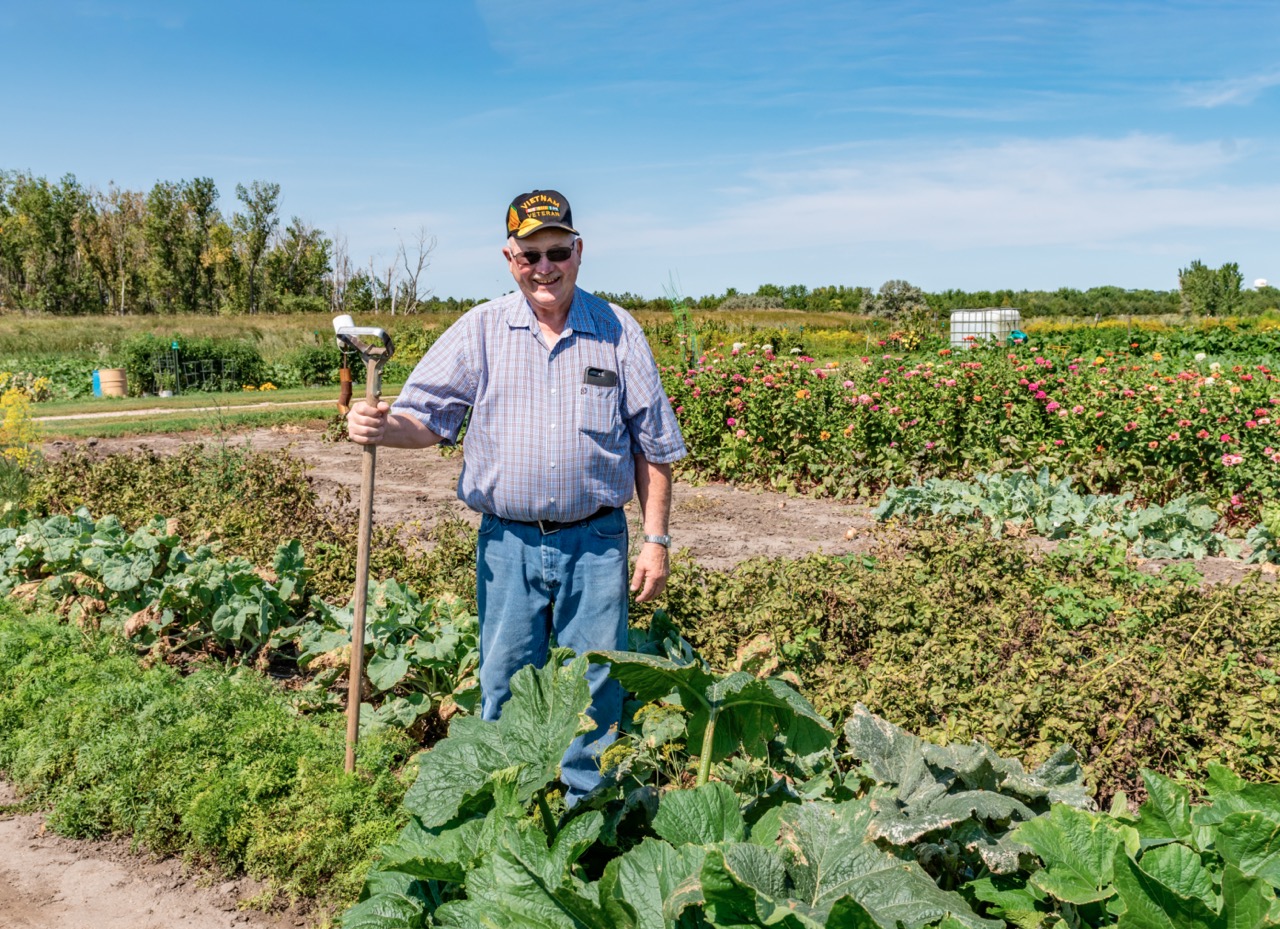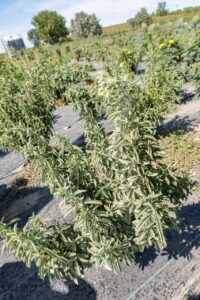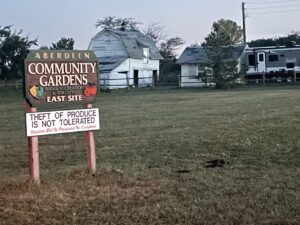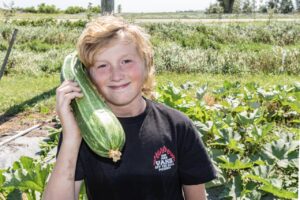

I would make a great donut gardener. I like the planning and planting, and I like the harvesting and eating, but there’s a hole in the middle when it comes to weeding and hoeing and watering and weeding. So I’m impressed by people who have the discipline to do the work, especially if they don’t really have the space for a garden. Fortunately for them, the City of Aberdeen has an answer.
Since the 1970s, the City has offered gardening plots for people without room at their homes for a garden. Aaron Kiesz, City Forester since 2006, heads the Forestry Division of the Parks and Recreation Department, which manages the Community Gardens. Back issues of the American News credit the late Ernie Hassenger with helping to establish the gardens in 1978. Not coincidentally, he was also a mover behind Natural Abundance Food Coop and the Farmer’s Market.
Kiesz admits he must rely on some long-term gardeners for the history of a program that began three decades before he started the job. Ray Andersh, age 82, remembers gardening plots since before they belonged to the City. “It was a private lot owned by a California woman with a local relative,” he recalls about what are now called the Taft Street Gardens, just south of 8th Avenue along the west side of Moccasin Creek. “We’d rent plots from her,” he said. “When the City built the bike path along the Mog, they planned to lease the property, but the gardeners convinced the City to buy the lot.”
PLANNING

Zac Hook experimented with planting Stevia plants, the leaves of which are used as a cane sugar substitute.
By the mid-1980s, the City laid out gardens south of Melgaard Road on either side of the Mog. Of the total 182 plots in four sites around town, more than four out of five are in the two south locations, with most in the East Gardens. More recently, the Northwest Gardens were established west of Presentation College.
Andersh remembers that in the early years, “The gardens had lots of the same people. The only time we got a new neighbor was when someone died.” He added, “We very seldom had empty plots.”
Kiesz generally confirmed that recollection. “For years, we used to have a waiting list of 20 people,” he said. “Now we have 20 unused plots”—the assumption being older gardeners dropping out aren’t being replaced by younger ones. At the same time, many renew. “About 75 percent of gardeners return each year,” he noted. “The rest is some turnover, with new people giving it a try.”
Throughout the program’s history, the City rewarded good gardeners with easy renewal of their plots each year. “If you have a garden and are doing it well,” Kiesz says, “we make it available for you to keep it.” After previous gardeners claimed their plots, Parks and Rec used to have a spring meeting at which remaining plots were distributed through a kind of lottery. At the beginning of the pandemic, that shifted to a call-in system, which continues to work as demand has declined. This year’s call-in date is March 23, 2023.
With fewer gardeners, Kiesz has also been able to relax some restrictions. In prior years, there was a limit of two plots per person. Now gardeners can get three, and sometimes more (with a partner). Kiesz believes “about 25 percent have two plots, and a few, less than 5 percent, have three.”
Most plots are 1,200 square feet, with a few half-plots available. Full-size plots are available for $20 for a year (not much above the $12 charge in the 1980s), and half-size are $10. Although it’s generally an informal system, “We do have some rules,” Kiesz said, listing the key points:
Don’t plant before the spring tilling. “It always seems somebody goes too early,” he said.
Keep your weeds down. “Some gardeners complain when neighbors don’t weed well enough. Most complaints are about weeds.”
Don’t go beyond your space. “One year somebody moved their garden to the creek bed, and we had to stop that.”
Fortunately, he said, a gentle reminder usually does the trick.
PLANTING

Zac Hook lays down weed barrier and even has a gravity-fed watering system. His kids, Rowynn, Ristynn, and Rorye often help tend to the plots and to sample the bounty.
It seems like a good deal. How does it work for gardeners? In the 2022 gardening season, I visited with a few. Andersh was pretty clear. “I’m a happy, satisfied gardener,” he said. “The City takes care of us out there. They till before we plant in the spring, then plow it under in the fall.” Having had two plots for many years, he’s less able to garden as regularly and now has a partner who does most of labor.
For more than 20 years, retired construction worker Gary Morehouse has had two plots in Melgaard East. He started on the west side then moved east to help a friend and stayed after the friend passed away. Previously, he lived south of Northern State University near a railroad right of way where he put in a garden. When he moved to his current home, however, there wasn’t room for a garden, so he set up down south.
Mary Raile has one full plot and two side-by-side half-plots in the Taft Gardens. She has also been in the Community Gardens for about 20 years, but “It took four years to get my foot in the door, after being on the waiting list,” she said. That was when she got one of the half-plots she has now. About ten years ago, she assembled her current allotment. Once the “new kid on the block,” whom the old timers said wasn’t doing things right, now she has almost the longest tenure. “I’m an ‘oldie’ now,” she laughed, “an ‘oldie but a goodie.’”
Game, Fish & Parks employee Zac Hook has plots on the far south end of Melgaard East. Working with a partner, he’s gardened there for six years. He started in the northernmost plot but lost plants to the neighbor’s chickens. The next year, he moved almost all the way south, where he got plots next to the late Del Griffin, “whose garden was always spotless.” When Griffin died in early 2021, Hook acquired his plots. Now, instead of chickens, he loses okra to deer.
CULTIVATING
The people I spoke with garden for similar reasons. Morehouse, who comes from a large family, remembers, “Ma put in a garden about this size, and that’s how I got started, going out to help her. She had twelve kids—had to feed them somehow!” Ultimately, he explained, “I just like to do it. It gives me something to do.” He added with a grin, “I tell my wife it keeps me out of the bars. It’s kind of my therapy.”
Raile, who says she probably gardens because her mom did, lives three houses north of Taft. She gardens there because she wanted to save her backyard for her day care children. Always wanting them to be friendly with the elderly, she brought the kids to visit gardeners. The proximity has a very practical benefit as well. She can pull a garden hose from her house to fill barrels at the garden, which she does “very early in morning so I don’t interrupt my neighbors.”
Last year, Raile planted brussels sprouts, tomatoes, kohlrabi, sweet potatoes, muskmelon, watermelon, green peppers, and more. “I swore I’d never plant green beans because after my sisters and I would collect beans, Mom would go through and find more,” she said, ruefully, “Now I plant beans.”
She uses bottomless coffee cans for a lot of her plants, because it helps concentrate watering. While she uses water from her house, some gardeners pump water from the Mog, and she has been amazed that creek water “would be clean in the bucket after it settled.”
Morehouse grew beets, onions, potatoes, rutabagas, carrots, zucchini, cucumber, cabbage, plus flowers for the bees they attract for pollination He gardens by himself today, but in the past he did the weeding and hoeing, and the lady who lived next door picked the garden at the end of the season. “We each did what we liked.”
“Everything you can get out of a seed catalog, I plant,” Hook said. As we walked through his several plots, he listed what was in them—a list he kept adding to throughout our visit (without duplicating the others’ lists here): corn, garlic, broccoli, okra, strawberries, eggplant, pumpkins, summer squash, herbs, celery, hot peppers, bell peppers, jalapeno, poblano, sweet potatoes, and more.
Hook asked the City not to till his plots, because “I want to do minimum till in my garden.” He also adopts some regenerative and organic agriculture techniques.
Landscaping fabric covered much of his garden to reduce weeds. He cut holes in it and, like Raile, put plants in cans. He also tries not to use chemicals that go in the ground because “I try to be as organic as I can.” Ultimately, he explains, “I grow my own stuff because this way I know what I’m getting”—and, he adds, “what’s gone on them.”
HARVEST
A 1,200 square foot plot can produce a lot of produce. After taking what they need, what do the gardeners do with their harvest? I came home with bags of veggies, and if I was any indication, they give a lot away.
When Morehouse harvests, he gives his sister-in-law beets, and she makes him beet pickles. “What we don’t eat,” he added, “we give away to neighbors and other gardeners.” He gave some once to an Asian neighbor whose plot got flooded by the Mog. “He doesn’t speak English, but he understood the offer.”
With his produce, Hook makes salsa and sauerkraut. Returning to the Gardens’ roots, so to speak, he has also sold some at the Farmer’s Market and Natural Abundance. If he has extra produce, he likes giving it away to people who don’t have gardens.
After Raile loaded me up with free veggies, she said, “I like my tomatoes more than any store-bought.” She also doesn’t need to buy watermelon or muskmelon. Plus she cans and pickles a lot and likes to compare her costs to the prices in the store.
GARDEN CULTURE
Gardeners aren’t all the same. Or maybe they are. Several Asian newcomers, Karen people from Thailand who made their way to Aberdeen for jobs that couldn’t be filled locally, grow at the Community Gardens. About two out of every five plots in the east Melgaard plots belong to Karen gardeners.
Hook said he’s learned a lot about what you can and can’t eat watching his Karen garden neighbors, including things that we think of as weeds. Morehouse added the Asians pick creeping jenny and put it in salads.
First Baptist Church has a special ministry for the Karen. It’s a large enough congregation that when a building on church property was removed, Pastor Gary Compton turned the space into garden plots the Karen use, because, he said, “having a garden makes it feel like home for them.”
One of those gardeners is Mar Gret, who began gardening at the church when she got sick a few years ago and, as translated by her daughter Poe Poh, “had nothing to do at home.” She had gardened in Thailand, and “Gardening here makes me happier.”
She grows some of the same vegetables as the other gardeners plus some that are more common in Asia, such as red chilis, green pumpkins, water spinach, long beans, and green bitter gourd vine seeds. While some seeds are available in Aberdeen’s Asian stores, Mar Gret obtained what she needed on a trip to Thailand.
Mar Gret grows more than the family needs and says, “It makes me happy to give my extra to friends.” When we talked in October 2022, after Mar Gret had cleared her garden, Poe Poh was excited to find a few uncollected red chilis, noting that veggies her mom grows save them money. “We didn’t have to buy vegetables all summer!” she smiled.
HARVEST
Gardening is a healthy activity in more ways than one (the donut approach is not one of them). Even if you don’t have the space at your place—or don’t want to give it up—Aberdeen makes it easy—or at least easier. If you’re reading this in the spring, there’s still time call Parks and Rec, pick up a spade, and turn over a new leaf. //
GROWING FOR THE GRADE
Reminiscent of a stray offshoot growing off the southwest corner of NSU’s Mewaldt-Jensen building, the first of NSU’s greenhouses is home to lots of growth, life, and education. Jodie Ramsay, a biology professor at Northern for 22 years, leads much of that learning. Besides teaching three plant courses, she grows many plants needed for classes, supports independent plant research, and works inside a fascinating high-tech space.
Ten years ago, NSU had no greenhouse. Today, after a wild rush of growth on campus, it has two. The MJ greenhouse opened in 2015. A few years later, a smaller greenhouse was incorporated in the Jewett Regional Science Education Center, where much student work ends up because most science classrooms are there.
Ramsay, who co-owns a greenhouse in Minnesota that she operates in the summer, has a few student workers who help during the year. She and the workers “grow plants for various classes to use, like the photosynthesis lab or classes such as General Biology, Ecology, or plant-specific courses.” Students sometimes grow their own for research projects or independent study. “If plants are needed for a class, we will start them in the greenhouse,” she noted. That often involves propagation by growing plants from cuttings of parent plants.
From the outside, it looks like a classic greenhouse, but the MJ unit is high-tech. “It has a weather station that will respond to changing conditions,” Ramsay said. “It will open or close vents or move a ceiling shade depending on what the weather is doing. We can set the system’s thermostat to trigger responses to weather conditions.” In addition, two of the rooms can be sealed off for biotech work
All Biology and Environmental Science majors have to take Biology 153 which covers, in part,the diversity of all living organisms plus a plant course, so they all connect with the greenhouse in some way Ramsay estimated about 50% of students grow their own plants there. The experience teaches them about plant diversity by studying plants from mosses to flowering plants, and propagation by growing from seeds or cuttings.
Just east of the MJ greenhouse is a pollinator garden, and NSU maintains another at the City Arboretum. The gardens were created several years ago with a grant from South Dakota Game, Fish & Parks. The gardens qualify as monarch waystations because they include multiple species of plants that pollinators feed on (learn more, including how to make your own, at monarchwatch.org).
The greenhouses are occasionally open to the public for tours and talks. Ramsay noted that the carnivorous plants in the science building are quite popular.

Aaron Kiesz said there are rare reports of theft, usually in the fall, and usually pumpkins. No matter what, that’s not what the community in Community Gardens means. Hence, today, there are signs at the gardens with the warning “Theft of produce is not tolerated.”



















